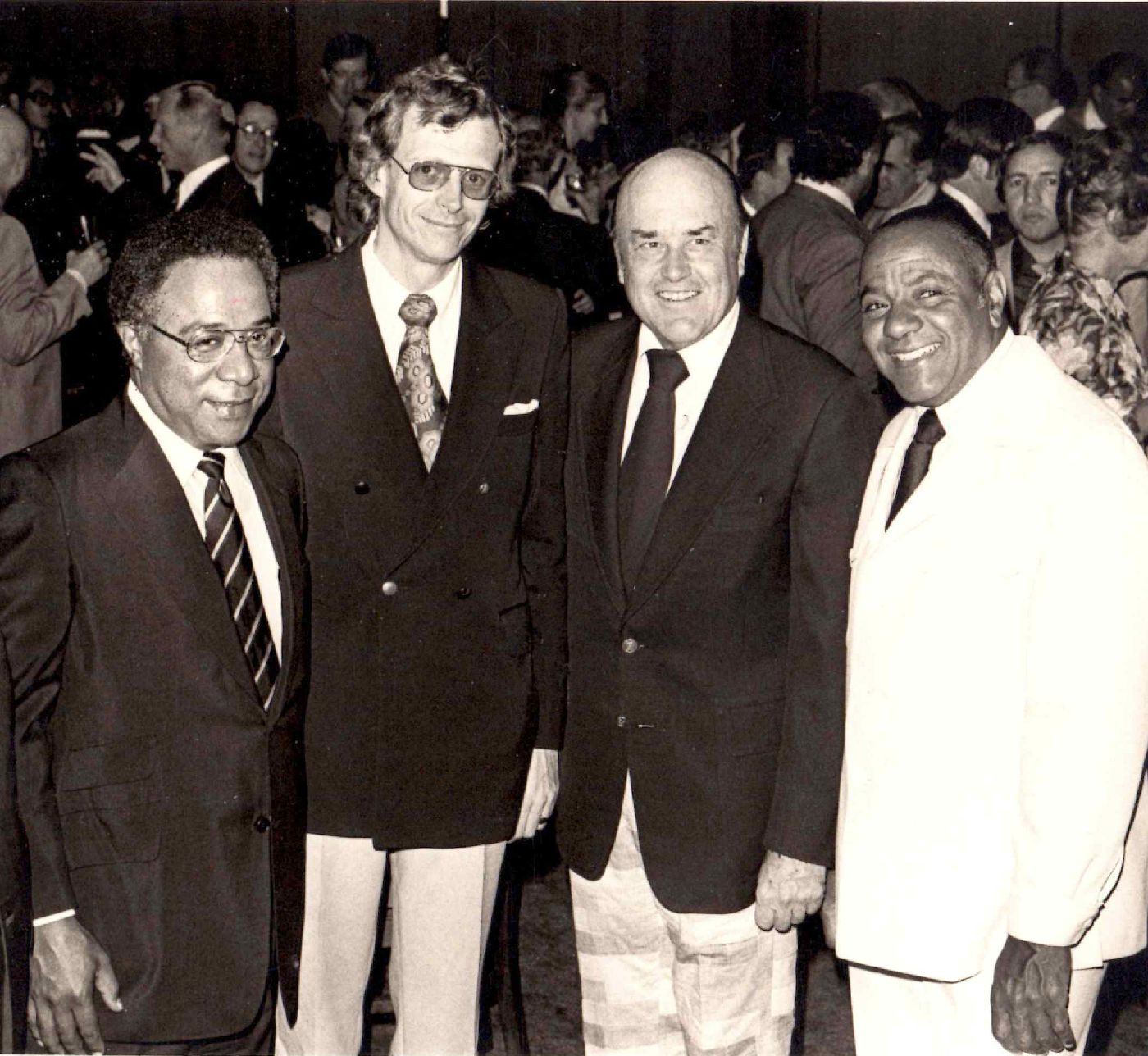
Plotting James A. Michener's Novel, The Covenant
In May 1978, Michener and I began the plotting of The Covenant sitting down for two four-day sessions with an intervening weekend during which I typed a draft outline.
A year later on April 15, 1979, Michener wrote the first of two memos about those meetings suggesting that what I brought to the table was "an exciting adventure story about diamonds," while he'd already outlined a South African novel based on a "Dutch family, a Zulu component and a conflict with the British."
15 April, 1979
Long before he met me, Errol Uys devised what could have been an exciting adventure story about diamonds, Arabian emirs, prospectors and some rattling good South African and American characters. He outlined his proposed novel in extensive detail, featuring intricate plot relationships among a considerable collection of characters, but did no writing.Long before I met Uys I had outlined a South African novel based on a Dutch family, a Zulu component and a conflict with the British. I stressed a Cape Town-to-Zimbabwe axis and ruthlessly excluded Natal, Southwest Africa and Kimberley, as I did not want to get involved in British settlements, Namibia or diamonds. But because of other pressures, and my inability as I saw it to get back to South Africa, I put this novel on the back burner and let it stay there for about eight years.
Then Tony Oursler of the Reader's Digest called one day to see if he could talk with me about his idea for a novel, and he told me of Uys's work, but more important, of Uys's presence in the United States and his eagerness to work with me on some South African materials. He outlined Uys's diamond novel briefly, and I said I'd not be interested in that line of development at all, but that I had long had my own thoughts on the matter and that if Uys and the South African arm of the Digest wanted to help with research material, I'd be interested. Especially, it was Oursler and Uys who proposed the diamond as the continuing factor in the story, and this appealed to me, but again, not as they supposed. In my version the diamond would never surface.
Then Uys and I met, most congenially, and I outlined my concept of the novel that I thought would make a contribution, and I rarely said one word but Uys immediately envisioned what I had in mind, and he rarely made a suggestion but what I could instantly see its applicability. (sic) We spent some four days with my outlining what was necessary, and he returned home to draft this document, using my ideas as a base line, adding his own inventive suggestions. We then met for another four days, after which he revised our outline along the lines my thoughts had been going. I then laid the whole aside and started to write from a fresh start, as it were, keeping basic structures in mind but allowing the story to develop itself. I write this memorandum as I finish Chapter VII, aware of how far I've strayed from our a priori ideas, but also aware of how valuable the pre-planning has been. Until a story gets a life of its own, one never know where it is going to lead, and that's always the best way.
16 April 1979
This is the beautifully worked-out plot that Errol Uys had in his possession when we first met to discuss whether or not he could find it congenial to work with me, and I with him. It should be studied carefully to see the points at which he had anticipated some of my own ideas, where he paralleled some, and where he introduced lines that I found quite extraneous.Examples of the latter are the Iranians in whom I could show no interest whatever, (Green); the American line (Black) although after having composed my last chapter with an Australian I diverted to an American as more fruitful; most of the English line (Green also) which seemed too melodramatic for me; and much of the Bantu (Blue and Brown) which again seemed too dramatic. There were, of course, elements in all the lines which had no attraction.Examples of the first, in which Uys anticipated me beautifully, were the background materials on the creation of the diamond (that is the geology, which has always been a preoccupation with me and not specifically the diamond itself); the man-apes; Australopithecus, although I could express no interest in Pithecanthropus for the good reason that I know nothing whatever about him; the Bushmen; the fleeting allusion to Zimbabwe, which had always been of major importance to me. Indeed, it was Uys's interest in these pre-historical materials which attracted me to him, for without an understanding of how my mind works on such themes he would have been unable to keep pace.
Examples of the middle group, the rough parallels, are numerous: Boer War, the shebeen, the good feeling for the Afrikaner, the elephant hunter (which I did not use but whose characteristics so closely paralleled my Mal Adriaan.) and the solid glimpses of the English at work and play.
Now let's look at the lines of actual plot development that he liked but which I found it better to avoid: The Portuguese, the heavy emphasis on Kimberley, the witchdoctor's ownership of the diamond; indeed the entire diamond theme; the Americans at Kimberley; the New York diamond merchants etc. I'm sure Uys would have discarded an equal amount of the ideas I'd developed, so the rejection was neither excessive nor important.
Finally, let's look at the large themes which I had generated prior to meeting Uys: the concept of 1647 as the beginning of the novel; the heavy emphasis on Java rather than Holland; the strong emphasis on the Huguenots, especially their religious background; the very heavy emphasis on the English; the long detail to be given to early Cape Town, a wine farm and the Trekboers; the confrontation with the Xhosa; the strong focus on the Voortrekkers; an equally strong focus on the Boer War and especially the concentration camps; the long sympathetic look at how a real Afrikaner was educated; and the sharp comment on apartheid. And in place of Uys's dramatics, I had from the start preferred emphasis on setting, slow development and the establishment of a site to which I could return again and again.
Now let's look at the specifics which Uys introduced into our long chat sessions when the big idea were thrown onto the table. He showed such a mastery and predilection for plotting that again and again he came up with dazzling ideas that again and again attracted my attention. I am no good at plotting, hold it to be almost an excrescence, and pay far to little attention to it, so that Uys's bold suggestions were often appreciated. It was he who suggested most of the coincidences, most of the confrontations, most of the wild occurrences and it was I who rejected a vast majority of them but I was deeply indebted to him for certain plot lines.
As one can see, I accepted almost none from his own outline, but when we talked he was so quick to catch ideas that we bounced large concepts about with ease. He really was a remarkable man in his ability to visualize instantly and I rarely had to waste a moment explaining anything. Also, he had the capacity and willingness to catch an idea and run with it in his own direction, often proposing something so far from my intention that I was bedazzled. I judge he could plot six novels a year with intricate beauties; he should have been in G-2 in some complicated war situation.
Never once did I say, "So now we have this Englishman at the Mission Station in 1819. How does he get to the Orange River?" without his having nine or eleven possibilities, all good, all logical, all beautifully coordinated. Often I would say, "too complicated for our boy", or "I doubt that our boy would go so far," but just as often I would say, "That might be just what he'd do."
Once we broke away from his conception of a super-dramatic novel, at which he would have been excellent, he grasped immediately and totally my concept of a novel which would unfold the qualities of the Afrikaner heritage, and although he sometimes took a dim view of that heritage, he was brilliant in bringing to my attention aspects which I could not have thought of by myself, even though I had done and was doing considerable work in the field. [*This item is from the James A. Michener special collection at the University of Northern Colorado, Greeley.]
I first saw these memos in 2000 when Dr. Barbara Helly brought them to my attention. A post-graduate student at the University of Rennes, France, Helly was in the U.S. researching The Covenant as basis for her English doctoral thesis.
Something about the two memos nagged at me: Why after we worked together for a year did Michener suddenly feel compelled to offer a detailed explanation of the genesis of The Covenant?
Why did he go to the trouble of stressing a schema I'd drawn up following my initial talks with Oursler, a plan that was thrown out of the door the moment Michener and I sat down to serious discussion at Maryland?
30 March, 1979
Several well-intentioned people have written to me recommending that I read the books of Wilbur Smith, especially The Sun Bird and Gold.For that reason it's important that I not read his books. As you know I've tried to steer completely clear of any novels, not wanting to run even the slightest risk of borrowing from them. The only novel I've read, so far as I can recall, is Prinsloo (Prinsloo of Prinsloo's Dorp), and I think it is out of copyright. (I've also read, years ago, Jock of the Bushveld, and I suppose it's out of copyright too.)
Please do not in any of your work, cite material from novels or short stories, as I have always tried to avoid such work. I adopted this policy long ago and I believe I spoke to Philip about my attitude, but the recent court cases involving Alex Haley's Roots, in which he borrowed bluntly and without good judgment, have alerted us anew to this problem.

The memos of April 15 and April 16, 1979 would not be Jim's last word on my role in the plotting of the novel. For example, Michener's archival notes for The Covenant materials report:
2. This novel had an unusual genesis. I planned it first in 1970 or thereabouts, prior to my first visit to South Africa. At that time I knew the surrounding countries well, having made several extended trips into the area. But I needed to see the land at first hand, so during that first trip I plotted a series of major short stories, connected into novel form, and some of these exists in the finished novel. But I felt I didn't know enough, so that idea perished and I would certainly not have gone ahead had not Tony Oursler of the Reader's Digest called me on the phone to tell me that his organization had two highly skilled editors* free at the moment, and they had been thinking about a book on South Africa and were free to work with me if I ever planned to do such a book. Item #2 shows the planning that Errol Uys, the principal editor, had completed long before he ever heard of me. My note pasted to the front indicates the relationship of Uys and his material to the plan that I had devised much earlier.
3. This represents Uys' reporting and summary of the heavy planning we did over several extended meetings covering many days. There was little of Uys' super-dramatic outline I could use - his original, that is - and his excellent concept of the diamond as a continuing thread, while it worked well for me, was ultimately discarded by the editors, to my deep regret, I must say. But the book was over-long and something had to go. The four families were my idea, from far in the past, and the book would be built around that, but Uys's clever extensions and interlockings mark every chapter.
(* Note: I was the only editor involved at this stage. I subsequently engaged Philip Bateman as an assistant in South Africa. See Research.)
A final (and different) commentary on The Covenant's genesis appears in a 1980 message to members of The Literary Guild for the book club edition. Jim describes his five-week visit to South Africa in 1971 and writes:
I came home all steamed up about writing a novel on the South African experience. I framed it around four basic themes: (1) The Bushman moving south across the desert. (2) The coming of the Huguenots. (3) The Great Trek north of the Dutch. (4) The Mfecane, that amazing eruption of the Zulu in the 1820s. These stepping stones would bring me down to the present, where I would deal with several incidents in contemporary life which had stunned me. In no way would I be able to write about South Africa without speaking of apartheid, the system whereby the races are kept completely separated.
But when I came to draft my novel - which dealt with all these matters from the outside, as seen by a visitor - I realized this was not a satisfactory approach. The novel had to be written from the inside, and I did not at that time know enough to write in that fashion.
So I dropped the subject and wrote instead Centennial, which dealt with a land I knew well, the sugar-beet fields along the South Platte River in Colorado, and then Chesapeake, which dealt with waters I knew well. I supposed I would never know enough to go back to the South African subject.
Then a pair of wonderful accidents revived the topic. The Reader's Digest had two editors with spare time on their hands, one working in the United States, one in South Africa. Each was a citizen of South Africa. Each was a fine writer. Each knew a lot about editing and researching. And they were eager to help on exactly the kind of project I had visualized. Within four days an arrangement was concluded, and I was off to South Africa to resume my education.
This is, of course, a promotional piece for the Literary Guild prepared with benefit of hindsight. The statement about four basic themes going back to 1971 is interesting, if compared with what Michener says in his letter of April 22, 1978 with his initial response to my outline and notes sent to Maryland after the meeting with Oursler at the University Club, especially his disinterest in the Bushmen (San) and intention to bypass Shaka and the Mfecane. At that time, he wrote...
"Basically, the only difference between Uys's outline and mine is that as always I want to take things slowly, avoid the big central occurrences, avoid the big cities that others can write about better than I, avoid the super-dramatic confrontations, lay emphasis upon the physical settings which enclose all of us wherever we might be, and allow the story to unfold with its symbolism implied rather than stated, and its high moral instinct in the yarn rather than spelled out in chapter headings. These are devices and principles which I have worked out over several decades, and they fit my personality and skills, and to abandon them now would be perilous. (Also, they work!)
... I am impressed by Uys's belief that there out to be two interpositions between Australopithecus and Zimbabwe; the Bushmen and the putative Phoenicians, Arabians and Ophirites. I have done no work on the Bushmen and had planned to play them down in comparison with the Hottentots, whom I want to make a strong feature as those present when the Dutch arrived.
... Naturally I would not want to attempt this important and difficult book if I did not do ample justice to the great black tribes, and I have always had this in mind from the time years ago when I studied the Zulus intensely, visiting their new lands, their old battlefields, their university and their present-day homes. But I'm damned if I see clearly how best to handle this. I had thought I would focus on the Xhosa as the people who were forced south and west by Shaka, and this still appeals. But I belatedly see that the story is only half told if full emphasis is not given to Shaka, his antecedents and his followers in addition to Dingaan. But every instinct tells me to wait on this till after the Dutch have been established. It makes for a better book, I am convinced. I am, however, open for suggestions as how best to introduce the material.
. . . Like Uys I want to stress the Huguenot strain, but as of now I have no clear plan for accomplishing this. I deem the French influence to be rather stronger than the average writer indicates; many of the profound strains of the Dutch-Boer-Afrikaans character show a clear Huguenot component. But this can be easily worked out as the characters move across the pages.
... My Chapter V, assuming that the French do not merit a chapter to themselves but an ancillary treatment, would leap directly to the Xhosa Wars and the coming of the English as a kind of afterthought. This could be a very solid and focal chapter, stressing the confrontation of Xhosa-Dutch and Dutch-English. But I have never done much work on the Xhosa, except as they were caught in Zulu history, and would need a lot of specific work to make myself competent. I much prefer the Zulus and the Matabele, but the more I think about Afrikaner history, the more significant the Xhosa become, a fact I did not appreciate some years ago.
Then the trek, on which I am fairly well informed. I have always thought it ought to be done as the South African version of the American trek to the west, and the Russian trek to the east, and I want to place it in its proper physical setting, comparing it with those other great treks which were so much more significant in terms of numbers of people involved and miles covered, and so much less important psychologically.
I had always intended, as you know from what I told you, to bypass Natal, which meant also bypassing Dingaan, because I have always been much more interested in the trekkers who did just that. I felt that I could get all the values I wanted from the Xhosa, but what Uys said at our meeting made a deep impression on me and I have restudied this issue. Blood River is too important to be ignored, even though all my antecedents as a writer warn me to do so, and I am beginning to see how I can digress to that tragic scene and then get back on what is for me my main line. In fact, this can be done with certain advantages and should be, primarily for two reasons: Blood River is too deeply ingrained in Afrikaner memory to be ignored and is too good a phrase to be wasted; and I now think that the blacks I want to follow in the powerful later chapters ought to be Zulus.
And there my specific planning comes to a halt. (In my earlier notes I leapfrogged almost directly to the workings of the pass laws, which is too enormous a leap for a book of the kind I now visualize.) I want of course to establish the diamond theme, but not too heavily. I do not want to make much if anything of the Rhodes-Kruger confrontation, for others have done this commendably. Nor am I concerned about the Uitlanders or the fracases between the two Republics.
Whatever I decide upon this lacuna must lead to the Boer War, which I have fairly well structured. But I am not making any firm decisions because I want to see what happens to our characters in the preceding episodes: Boer heroes; English actors: Black majority.
As they move into the Twentieth Century their obligations become clearer, and I have always had this fairly well in mind: much emphasis on 1938-1945; great stress on the intellectual conflicts of the 1948-1960 period; and in the final chapter a focus on perhaps only three central figures, each of which grows out of the preceding periods.
I have already given some thought to Oursler's idea that an American enter the final scenes, and now I see that Uys had the same idea. There may be some value in this: a fresh figure, a new view, a premonition of the 1990s. I don't want to use the diamond melodramatically, but if it is well handled in the opening chapter, and then again prior to the Boer War, there could be a way of utilizing it within the limitations I set myself. At any rate, I'm think about this and have so far come up with nothing. But the idea does persist, so maybe it's a good one.
Now you know all I know and the next move is yours."
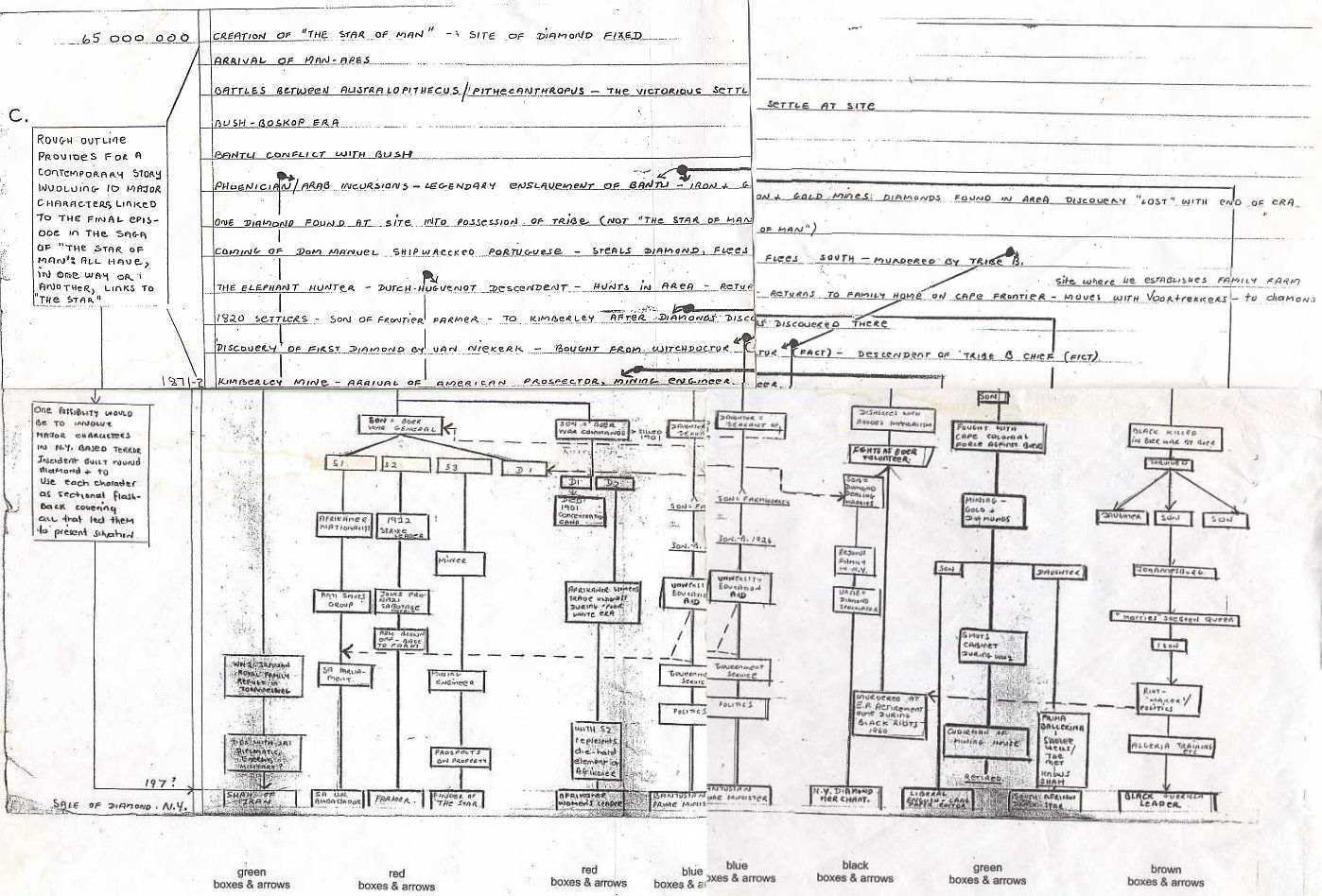
This early research with notes and articles from my library provided pointers to core themes that could be exploited in the proposed novel. For example, these are my notes culled from various sources about Australopithecus and other early denizens of the South African veld:
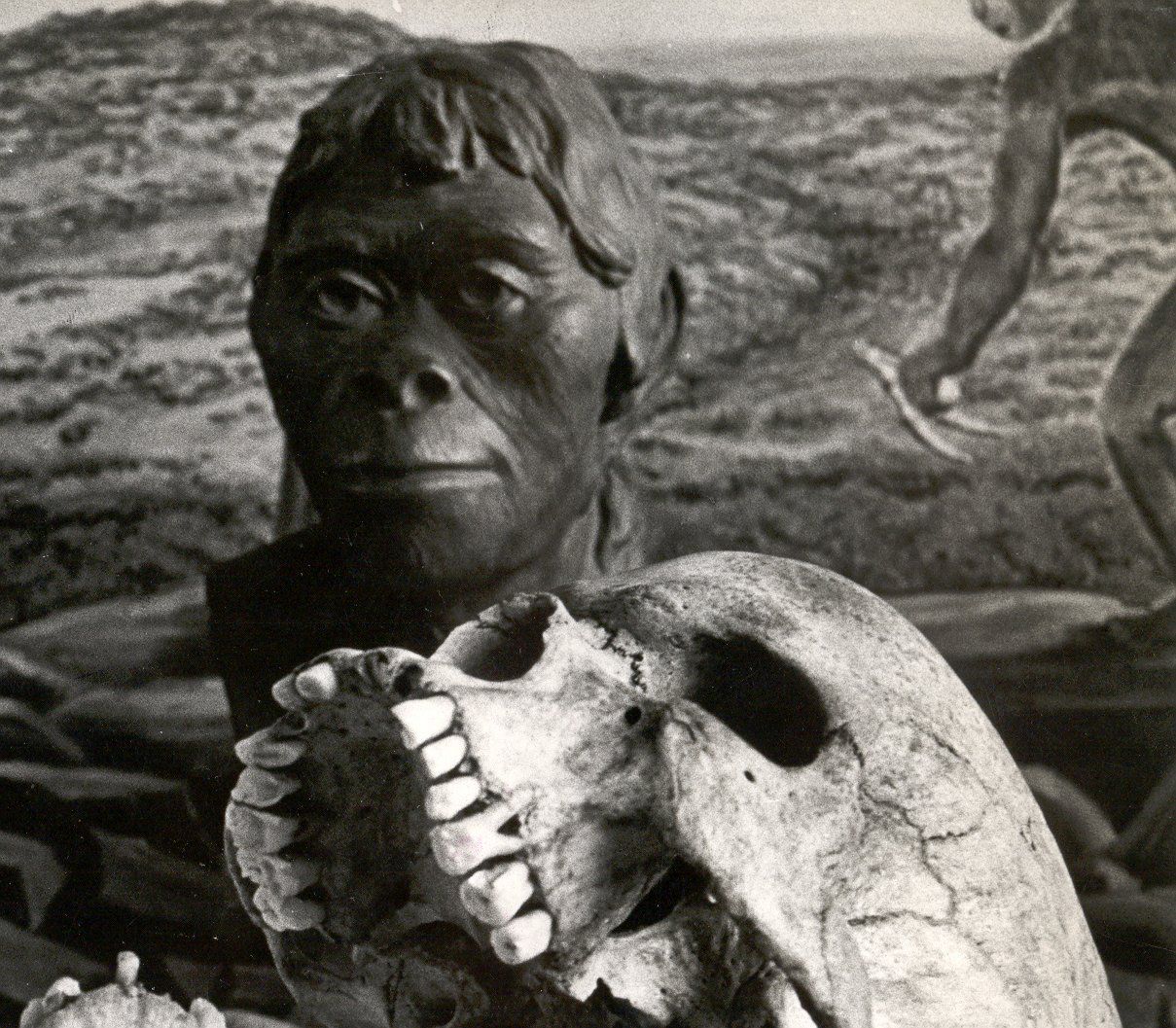
2,000,000 BC (could revise to 3.5M BC).Australopithecus. About five foot tall, walked upright and in his hand carried a crude weapon. Lived along Vaal River valley and probably roamed vast tracts of the Transvaal veld. He was crafty. As a scavenger he learnt to stalk animals and butcher them with his weapons. He was ugly; virtually no nose, massive jaws and a coarse and heavy face. About ninety pounds when full grown, their brain cavities suggest limited intelligence. It's been said of them - they knew enough to get into trouble but not enough to get out of it.
1,000,000 BC.Yet Australopithecus knew something of co-operating with the environment. They survived for over one million years and were supplanted only by a superior species, Pithecanthropus or man ape. Pithecanthropus, in turn, displaced by Neanderthal types and they by earlier and middle stone age men. Thus, dawn man lived at one time or another in almost every square mile of South Africa... Paleontologists are agreed on 1) in this part of the world, art of stone-working followed an evolution parallel to but not similar with that of Europe. 2) Southern Africa served as a refuge where peoples who have disappeared from all other part of the world have often survived, even to the present day. There was no Neolithic age in South Africa; there the Paleolithic age was prolonged by Bushman (San) civilization.
500,000 BC. Earlier stone age spanned some 500,000 years and saw little development in stone tool manufacture. Tools consisted of relatively large and heavy cleavers and almond-shaped hand-axes. Probably used for splitting open the long bones and skulls of animals, for cutting up meat and for digging pits in which to trap game.
12,000 BC.Later stone age, still represented in culture of living Bushman (San). Last of stone ages in South Africa was period during which man began to show skill as an artist. From rock paintings and engravings we have learned a great deal about his customs and ceremonies, the animals he hunted and feared, clothing he wore and his various hunting methods.
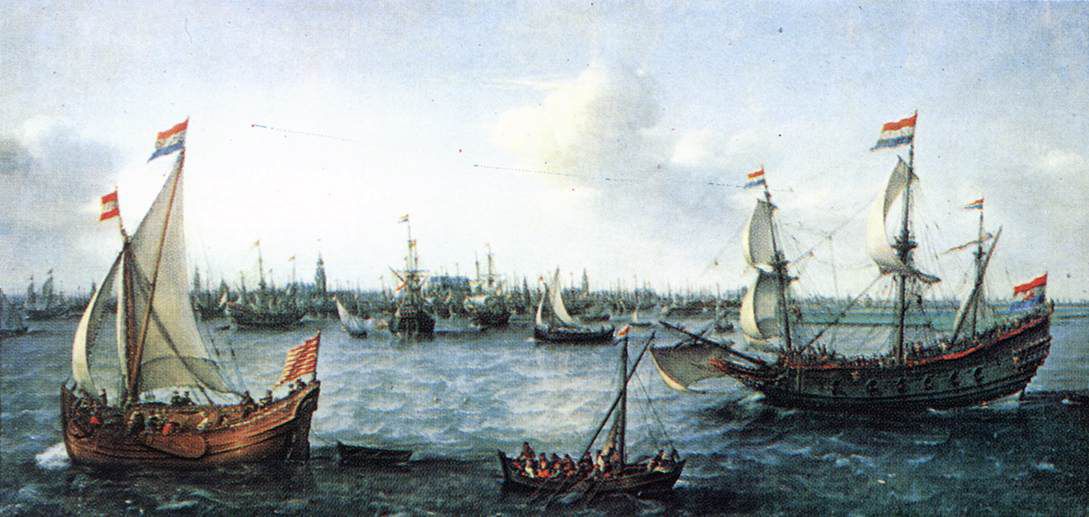
In my notes on the "discovery" period, I included the story of the wreck of the Dutch East Indiaman, Haerlem, and Fort Zandeburgh, a refuge built by the survivors who landed on the shores of Table Bay in 1647, five years before the Dutch settlement led by Jan van Riebeeck. In the Outline prepared from the initial brainstorming sessions held at St. Michaels, I wrote under Chapter Five:
The chapter introduces the first line of our major Dutch/Afrikaner family: The Van Doorns. Opens with the wreck of the Haerlem, a Dutch East Indiaman bound from Batavia for Holland which ran aground in Table Bay. Departing Batavia, Dec 22, 1646, in company of Olifant and Schiedam, Haerlem was wrecked on March 25, 1647. On April 12, the Schiedam sailed for Holland. On April 1, 1648, the Coninck van Poolen arrived from Batavia to pick up those survivors left behind to guard the cargo salvaged from Haerlem: Aboard this ship was Jan van Riebeeck returning to Holland somewhat in the company's disgrace for having traded privately at Batavia. Exonerated, in 1652, van Riebeeck, a doctor, would head the first Dutch settlement at the Cape. The two Van Doorns we're interested in are:
Paulus van Doorn, born Holland, 1615. In 1637, Paulus joined the Dutch East India Company, working for them in Amsterdam before being sent to Batavia.which he leaves aboard the Haerlem.Karel van Doorn, born Holland, 1625. Unable to obtain a post with the company, Karel goes to sea, getting a berth aboard the Haerlem.
After the wreck, Paulus van Doorn returns to Holland aboard the Schiedam. Karel stays behind with sixty or so men left with the salvage. Not only does he develop a keen attachment to the Cape, but will be recommended to the company for his loyal service during that year ashore. Records show that the senior officers left at the Cape had considerable difficulty in controlling the men under them. Sailing back aboard the Coninck van Poolen. Karel van Doorn meets Van Riebeeck who will assist him in joining the Company.
Chapter Six
The arrival of the Huguenots and Mal(Eccentric/Unconventional) Adriaan's story.1688: The chapter opens with description of voyage bringing a group of French Refugees to the Cape. Among them is the family of Paul du Pré (later du Preez) from Lille originally but later in Holland.(Again, if necessary, offers early connection to Van Doors through Paulus.) The voyage description will be detailed offering graphic account of the rigors, terrors etc. that had to be endured. It will suffice for all later-comers such as the 1820 settlers. In the group with the du Pré family is Jordain, a "visitor to the sick/lay preacher/teacher." An interesting aspect of the French Huguenot arrival - at the onset they comprised 25 per cent of the white population - is that within 35 years the French language had all but died out. Jordain will be used to reflect on this development.
The du Pré's settle in the Drakenstein valley as neighbors to Karel van Doorn and his family. [Note: Although there were but 187 Huguenots, it's accepted that they had an important influence in building the character of the Boer/Afrikaner, This will be examined, as also the background of the whole Huguenot persecution, probably in flashback style during the 1688 voyage.]
1690: Villages of Paarl and Franschoek founded.1693: Karel van Doorn dies.
1709: First land grant beyond the Hottentot-Hollands mountains.the first stirrings of the trek lust.
1711: Hendrik van Doorn marries Marie du Pré
1712: Adriaan van Doorn, born. (Hendrik/Marie)
1713: Smallpox epidemic
1723: Last church service held in French
1728: At 16, Adriaan van Doorn accompanies a Swedish naturalist on a trip to the interior. At this early developmental stage, Adriaan establishes himself as a strong character with a "vision," especially of the North. With the Swede, he will go as far inland as Vrymeer . he finds Bush paintings etc. and so graphic are his descriptions of the valley that they will be buried in the mind - and "legend" - of the Van Doorn descendants."
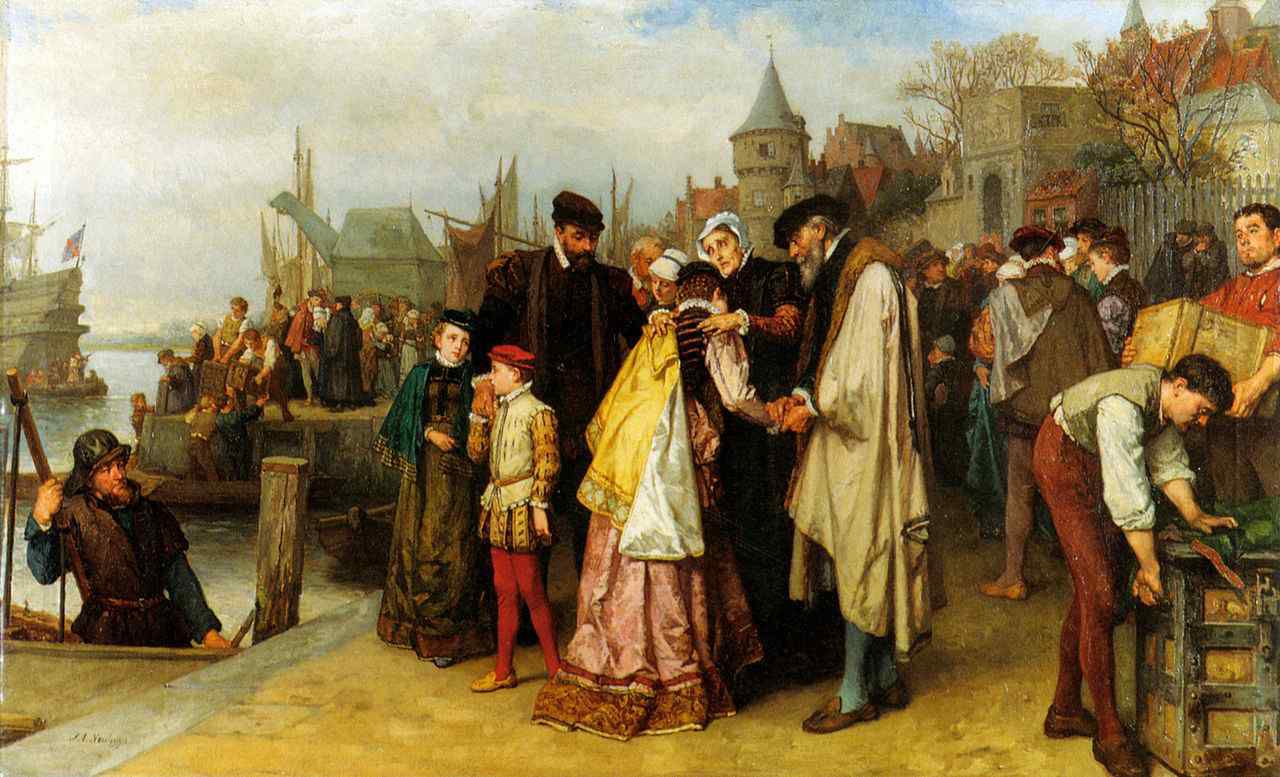
A final example of the outgrowth of ideas from my original "diamond" notes concerns the crucial sections on the Great Trek of the Voortrekker-Boers and the story of the Zulus. (As noted above, these research notes for Michener were culled from various sources.)
"If one-fifth of the population of a country were to leave its national territory, sociologists would not be able to find enough words to describe the exodus's motivations. Around 1835, the colony numbered some 60,000 whites of whom 14,000 emigrated within ten years.The Great Trek.
"Religion of Boers: They expressed themselves in Biblical terms, calling the natives 'Children of Ham and Canaanites. The King of England was Pharaoh: because of his oppression they had been forced to leave Cape Colony. They were on their way to the Promised Land. The Afrikaners had been called by Divine Providence to go from place to place as pioneers of civilization. To them had fallen the awesome task of conquering Africa for King Jesus.
"First leader, Piet Retief, 54, Huguenot stock, the Thomas Jefferson of the Great Trek. Declaration published before setting off: "As we desire to stand high in the estimation of our Brethren, the Boers would wherever they found themselves 'uphold the principles of Liberty.' There was one reservation: 'Whilst we will take care that no one shall be held in a state of slavery, it is our determination to maintain such regulations as may suppress crime and preserve proper relations between master and servant.'
"In 1838 Retief was slaughtered by Zulu king, Dingane. On 16 December, Battle of Blood River.Boers/Zulus.10-15,000 Zulus defeated by 500..
"Not many years passed before it became apparent that the Great Trek had resulted in the juxtaposition of two white South Africas: one still permeated with colonialism but priding itself in its humanitarian pre-occupations; the other, obsessed with republicanism and unconcerned with equality."
Alongside my notes on the Voortrekkers were references to the Zulus: "At beginning of the 19th century, Zulu nation wielded little power. In 1818, Shaka proclaimed chief. At this time he had 500 warriors at his command. On his death in 1828, his regiments numbered 50,000 and his sway extended over whole of present day Natal. From Kei River to Zambezi and from Indian Ocean to Botswana. The training of the young Zulu has been compared to that of the Spartans and Shaka's impis to the Roman legions. The tribes spent some fifteen years killing each other with such passion that experts put casualties at two million.
Eyewitness account of one battle: "At four spears throw, the deep, majestic Zulu war chant rolled like thunder across the valley.With the beginning of the chant, the speed of the warriors slowed down to the rhythmic, measured jog trot of a death dance and at every tenth step there was a shaking step of the right foot carried out in perfect unison. At one spear's throw, the chant ceased abruptly. There was a deadly silence for the time required to take a deep breath. Then the fearful Zulu war cry crashed out 'SI-JI-DI' and the Zulu charged."
Chapter Eight of the Outline deals with The Rise of the Zulu Nation.
Chapter Eight
Seen through the story of a young man who is friend, fellow-warrior and later bodyguard to Shaka. (Dingane, the Zulu despot defeated by the Voortrekkers at Blood river is handled in Chapter Nine.)1787: Shake born
1788: Nxumalo, young Amazulu friend of Shaka, meets with him in 1806. Nxumalo is forefather of main black characters in book.
1797: Nxumalo's father executed in savage way.e.g. for whistling in presence of tribal chief. Nxumalo witnesses this incident which opens the chapter.
1809: Shaka and Nxumalo join Dingiswayo's iziCwe regiment.Shaka increasingly active remains in Dingiswayo's regiments for six years. So does Nxumalo.
1818: Dingiswayo executed after capture by enemy tribe
1820: Shaka has risen to power until, by now, he is in control of most of Zululand.
During the consolidation period, thousands of enemy warriors are put to death. Known as the Mfecane, estimates have gone as high as two million, a figure added to by a final period of tyranny surpassing all:
1827, Oct 10: Death of Nandi, "female elephant" (title of honor).Shaka's mother. Shaka orders a year of mourning and murders thousand who fail to comply.
(In Chapter Nine, The Great Trek, the Van Doorns forsake the Cape Colony for the north and the inevitable clash with the Zulus:)
1836: December. Tjaart van Doorn and family trek to present-day Orange Free State. Tjaart has established a reputation as frontier "scout." Richard (Saltwood) buys Tjaart's farm.
1837: Voortrekker punitive raids against the Matabele. (In October previous year, the Trekkers had defeated the Matabele at Vegkop in the OFS)
1837: Trekker leader Piet Retief, one of moist outstanding, arrives at Winburg where 1,000 wagons are assembled.
1837: Retief, who sees Natal as the Promised Land, arrives at Port Natal (Durban)
1837: Nov: Punitive raids against the Matabele.driven to the Matopo hills near present-day Bulawayo.
1837: Tjaart van Doorn decides to go to Natal and moves his family over the Drakensberg; Jenny and the children, Boy/Two girls, aged 14, 8, 4.
1838: Tjaart leaves them in encampment to go to Drakensberg to assist a new party of Trekkers over the mountains. (Drakensberg = Mountains of the Dragon)
1838 Feb 6: Retief party murdered by Dingaan at his Royal Kraal
1838 Zulus attack Trekker settlements: Jenny van Doorn and the three children butchered at Blaauwkrantz.
1838 Nov: Commandos raised by Andries Pretorius.
1838 Dec 16: Battle of Blood River. Tjaart is present in the laager.
1839: To dull his grief and anger, Tjaart takes off alone on a trip north. In many ways, he is the reincarnation of Adriaan, the rebel/adventurer. Tjaart reaches Zimbabwe.offering connections to the past.to the meaning of the fall of the Rozwi empire etc.
1840: Tjaart van Doorn remarries.Aletta Naude, 18 year old survivor of Blaauwkrantz.
1841: On his trip to Zimbabwe, Tjaart had "found" Vrymeer: With Aletta, he now settles there, making friends with the Nxumalo group who live in a section of the valley. Tjaart, of course, does not know that this is Adriaan's Eden. (Perhaps .discourse on symbolic attraction of the Diamond.)
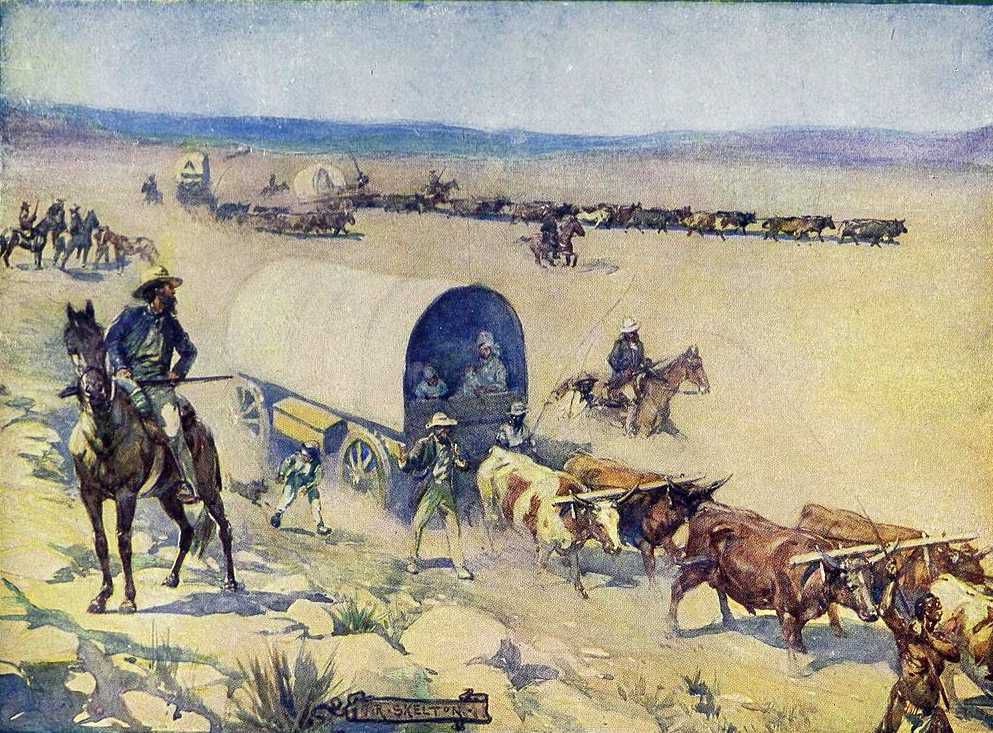
In his reflection on our plotting sessions, Jim gives a good account of the lively banter between us as we searched for the myriad leads and connections between our characters and the traits of the leading players themselves:
Uys showed such a mastery and predilection for plotting that again and again he came up with dazzling ideas that again and again attracted my attention. I am no good at plotting, hold it to be almost an excrescence, and pay far too little attention to it, so that Uys's bold suggestions were often appreciated. It was he who suggested most of the coincidences, most of the confrontations, most of the wild occurrences and it was I who rejected a vast majority of them but I was deeply indebted to him for certain plot lines.
As one can see, I accepted almost none from his own outline, but when we talked he was so quick to catch ideas that we bounced large concepts about with ease. He really was a remarkable man in his ability to visualize instantly and I rarely had to waste a moment explaining anything. Also, he had the capacity and willingness to catch an idea and run with it in his own direction, often proposing something so far from my intention that I was bedazzled. I judge he could plot six novels a year with intricate beauties; he should have been in G-2 in some complicated war situation."